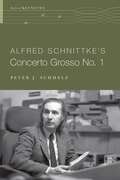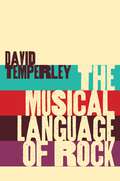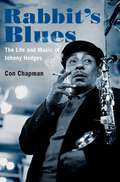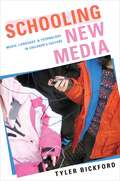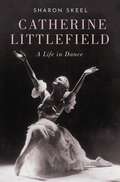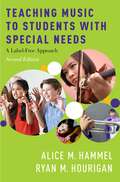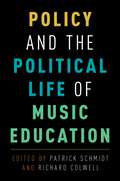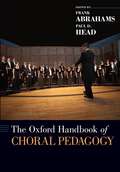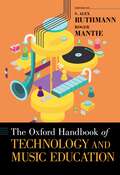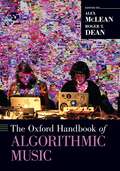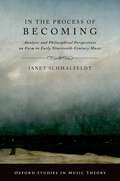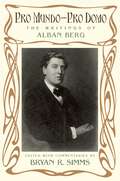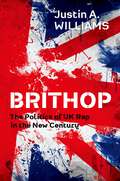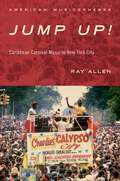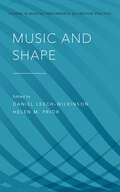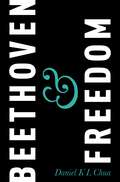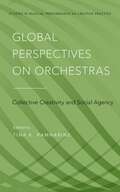- Table View
- List View
ALFRED SCHNIT CONCER GROSSO NO. 1 OKS C (The Oxford Keynotes Series)
by Peter J. SchmelzConcerto Grosso no. 1 is one of Alfred Schnittke's best-known and most compelling works, sounding the surface of late Soviet life while resonating with contemporary compositional currents around the world such as postmodernism. It marked a decisive point in Schnittke's development of the approach he called polystylism, which aimed to contain in a single composition the wide range of contemporary musical styles, including "jazz, pop, rock, or serial music." Thanks to it and his other similar compositions, Schnittke became one of the most-performed and most-recorded living composers at the end of the twentieth century. Peter J. Schmelz's Alfred Schnittke's Concerto Grosso no. 1 represents the first accessible and comprehensive study of this composition. The novel structure of the book engages with the piece conceptually, historically, musically, and phenomenologically, with the six movements of the composition framing the six chapters. Augmenting and complicating the insights of existing English, Russian, and German publications on the Concerto Grosso no. 1, the book adds new information from underused primary sources, including Schnittke's unpublished correspondence and his many published interviews. It engages further with his sketches for the piece, and with contemporary Soviet musical criticism, resulting in a more objective, historical account of this rich, multifaceted composition, its influences, and its impact on music making in the USSR and worldwide.
The Musical Language of Rock
by David TemperleyIn all of the books about rock music, relatively few focus on the purely musical dimensions of the style: dimensions of harmony and melody, tonality and scale, rhythm and meter, phrase structure and form, and emotional expression. The Musical Language of Rock puts forth a new, comprehensive theoretical framework for the study of rock music by addressing each of these aspects. Eastman music theorist and cognition researcher David Temperley brings together a conventional music-analytic approach with statistical corpus analysis to offer an innovative and insightful approach to the genre. With examples from across a broadly defined rock idiom encompassing everything from the Beatles to Deep Purple, Michael Jackson to Bonnie Raitt, The Musical Language of Rock shows how rock musicians exploit musical parameters to achieve aesthetic and expressive goals-for example, the manipulation of expectation and surprise, the communication of such oppositions as continuity/closure and tension/relaxation, and the expression of emotional states. A major innovation of the book is a three-dimensional model of musical expression-representing valence, energy, and tension-which proves to be a powerful tool for characterizing songs and also for tracing expressive shifts within them. The book includes many musical examples, with sound clips available on the book's website. The Musical Language of Rock presents new insights on the powerful musical mechanisms which have made rock a hallmark of our contemporary musical landscape.
MUSICAL LANGUAGE OF ROCK C
by David TemperleyIn all of the books about rock music, relatively few focus on the purely musical dimensions of the style: dimensions of harmony and melody, tonality and scale, rhythm and meter, phrase structure and form, and emotional expression. The Musical Language of Rock puts forth a new, comprehensive theoretical framework for the study of rock music by addressing each of these aspects. Eastman music theorist and cognition researcher David Temperley brings together a conventional music-analytic approach with statistical corpus analysis to offer an innovative and insightful approach to the genre. With examples from across a broadly defined rock idiom encompassing everything from the Beatles to Deep Purple, Michael Jackson to Bonnie Raitt, The Musical Language of Rock shows how rock musicians exploit musical parameters to achieve aesthetic and expressive goals-for example, the manipulation of expectation and surprise, the communication of such oppositions as continuity/closure and tension/relaxation, and the expression of emotional states. A major innovation of the book is a three-dimensional model of musical expression-representing valence, energy, and tension-which proves to be a powerful tool for characterizing songs and also for tracing expressive shifts within them. The book includes many musical examples, with sound clips available on the book's website. The Musical Language of Rock presents new insights on the powerful musical mechanisms which have made rock a hallmark of our contemporary musical landscape.
Rabbit's Blues: The Life and Music of Johnny Hodges
by Con ChapmanIn his eulogy of saxophonist Johnny Hodges (1907-70), Duke Ellington ended with the words, "Never the world's most highly animated showman or greatest stage personality, but a tone so beautiful it sometimes brought tears to the eyes--this was Johnny Hodges. This is Johnny Hodges." Hodges' unforgettable tone resonated throughout the jazz world over the greater part of the twentieth century. Benny Goodman described Hodges as "by far the greatest man on alto sax that I ever heard," and Charlie Parker compared him to Lily Pons, the operatic soprano. As a teenager, Hodges developed his playing style by imitating Sidney Bechet, the New Orleans soprano sax player, then honed it in late-night cutting sessions in New York and a succession of bands lead by Chick Webb, Willie "The Lion" Smith, and Luckey Roberts. In 1928 he joined Duke Ellington, beginning an association that would continue, with one interruption, until Hodges' death. Hodges' celebrated technique and silky tone marked him then, and still today, as one of the most important and influential saxophone players in the history of jazz. As the first ever biography on Johnny Hodges, Rabbit's Blues details his place as one of the premier artists of the alto sax in jazz history, and his role as co-composer with Ellington.
Rabbit's Blues: The Life and Music of Johnny Hodges
by Con ChapmanIn his eulogy of saxophonist Johnny Hodges (1907-70), Duke Ellington ended with the words, "Never the world's most highly animated showman or greatest stage personality, but a tone so beautiful it sometimes brought tears to the eyes--this was Johnny Hodges. This is Johnny Hodges." Hodges' unforgettable tone resonated throughout the jazz world over the greater part of the twentieth century. Benny Goodman described Hodges as "by far the greatest man on alto sax that I ever heard," and Charlie Parker compared him to Lily Pons, the operatic soprano. As a teenager, Hodges developed his playing style by imitating Sidney Bechet, the New Orleans soprano sax player, then honed it in late-night cutting sessions in New York and a succession of bands lead by Chick Webb, Willie "The Lion" Smith, and Luckey Roberts. In 1928 he joined Duke Ellington, beginning an association that would continue, with one interruption, until Hodges' death. Hodges' celebrated technique and silky tone marked him then, and still today, as one of the most important and influential saxophone players in the history of jazz. As the first ever biography on Johnny Hodges, Rabbit's Blues details his place as one of the premier artists of the alto sax in jazz history, and his role as co-composer with Ellington.
Schooling New Media: Music, Language, and Technology in Children's Culture
by Tyler BickfordPopular music and digital media are constantly entwined in elementary and middle-school children's talk, interactions, and relationships, and offer powerful cultural resources to children in their everyday struggles over institutionalized language, literacy, and expression in school. In Schooling New Media, author Tyler Bickford considers how digital music technologies are incorporated into children's expressive culture, their friendships, and their negotiations with adults about the place of language, music, and media in school. Schooling New Media is a groundbreaking study of children's music and media consumption practices, examining how transformations in music technologies influence the way children, their peers, and adults relate to one another. Based on long-term ethnographic research with a community of schoolchildren in Vermont, Bickford focuses on portable digital music devices - i.e. MP3 players - to reveal their key role in mediating intimate, face-to-face relationships and structuring children's interactions both with music and with each other. Schooling New Media provides an important ethnographic and theoretical intervention into ethnomusicology, childhood studies, and music education, emphasizing the importance-and yet under-appreciation-of interpersonal interactions and institutions like schools as sites of musical activity. Bickford explores how headphones facilitate these school-centered interactions, as groups of children share their earbuds with friends and listen to music together while participating in the dense overlap of talk, touch, and gesture of their peer groups. He argues that children treat MP3 players more like toys than technology, and that these devices expand the repertoires of childhood communicative practices such as passing notes and whispering-all means of interacting with friends beyond the reach of adults. These connections afforded by digital music listening enable children to directly challenge the language and literacy goals of classroom teachers. Bickford's Schooling New Media is unique in its intensive ethnographic attention to everyday sites of musical consumption and performance, and offers a sophisticated conceptual approach for understanding the problems and possibilities of children's uses of new media in schools.
Schooling New Media: Music, Language, and Technology in Children's Culture
by Tyler BickfordPopular music and digital media are constantly entwined in elementary and middle-school children's talk, interactions, and relationships, and offer powerful cultural resources to children in their everyday struggles over institutionalized language, literacy, and expression in school. In Schooling New Media, author Tyler Bickford considers how digital music technologies are incorporated into children's expressive culture, their friendships, and their negotiations with adults about the place of language, music, and media in school. Schooling New Media is a groundbreaking study of children's music and media consumption practices, examining how transformations in music technologies influence the way children, their peers, and adults relate to one another. Based on long-term ethnographic research with a community of schoolchildren in Vermont, Bickford focuses on portable digital music devices - i.e. MP3 players - to reveal their key role in mediating intimate, face-to-face relationships and structuring children's interactions both with music and with each other. Schooling New Media provides an important ethnographic and theoretical intervention into ethnomusicology, childhood studies, and music education, emphasizing the importance-and yet under-appreciation-of interpersonal interactions and institutions like schools as sites of musical activity. Bickford explores how headphones facilitate these school-centered interactions, as groups of children share their earbuds with friends and listen to music together while participating in the dense overlap of talk, touch, and gesture of their peer groups. He argues that children treat MP3 players more like toys than technology, and that these devices expand the repertoires of childhood communicative practices such as passing notes and whispering-all means of interacting with friends beyond the reach of adults. These connections afforded by digital music listening enable children to directly challenge the language and literacy goals of classroom teachers. Bickford's Schooling New Media is unique in its intensive ethnographic attention to everyday sites of musical consumption and performance, and offers a sophisticated conceptual approach for understanding the problems and possibilities of children's uses of new media in schools.
Catherine Littlefield: A Life in Dance
by Sharon SkeelWhile she is best remembered today as founder of the Philadelphia Ballet and the director and driving force behind the famous Littlefield School of Ballet, from which Balanchine drew the nucleus for his School of American Ballet, Catherine Littlefield (1905-51) and her oeuvre were in many ways emblematic of the full representation of dance throughout entertainments of the first half of the 20th century. From her early work as a teenager dancing for Florenz Ziegfeld to her later work in choreographing extravagant ice skating shows, a remarkable dance with 90 bicyclists for the 1940 World's Fair, and on television as resident choreographer for The Jimmy Durante Show, Littlefield was amongst the first choreographers to bring concert dance to broader venues, and her legacy lives on today in her enduring influence on generations of American ballet dancers. As the first biography of Littlefield, Catherine Littlefield: A Life in Dance traces her life in full from birth through childhood experiences dancing on the Academy of Music's grand stage, and from her foundation of the groundbreaking Philadelphia Ballet Company in 1935 to her later work in television and beyond. Littlefield counted among her many glamorous friends and colleagues writer Zelda Fitzgerald, conductor Leopold Stokowski, and composer Kurt Weill. This biography also provides an engrossing portrait of the remarkable Littlefield family, many of whom were instrumental to Catherine's success. With the unflagging support of her generous husband and indomitable mother, Littlefield gave shape to the course of American ballet in the 20th century long before Balanchine arrived in the United States.
Catherine Littlefield: A Life in Dance
by Sharon SkeelWhile she is best remembered today as founder of the Philadelphia Ballet and the director and driving force behind the famous Littlefield School of Ballet, from which Balanchine drew the nucleus for his School of American Ballet, Catherine Littlefield (1905-51) and her oeuvre were in many ways emblematic of the full representation of dance throughout entertainments of the first half of the 20th century. From her early work as a teenager dancing for Florenz Ziegfeld to her later work in choreographing extravagant ice skating shows, a remarkable dance with 90 bicyclists for the 1940 World's Fair, and on television as resident choreographer for The Jimmy Durante Show, Littlefield was amongst the first choreographers to bring concert dance to broader venues, and her legacy lives on today in her enduring influence on generations of American ballet dancers. As the first biography of Littlefield, Catherine Littlefield: A Life in Dance traces her life in full from birth through childhood experiences dancing on the Academy of Music's grand stage, and from her foundation of the groundbreaking Philadelphia Ballet Company in 1935 to her later work in television and beyond. Littlefield counted among her many glamorous friends and colleagues writer Zelda Fitzgerald, conductor Leopold Stokowski, and composer Kurt Weill. This biography also provides an engrossing portrait of the remarkable Littlefield family, many of whom were instrumental to Catherine's success. With the unflagging support of her generous husband and indomitable mother, Littlefield gave shape to the course of American ballet in the 20th century long before Balanchine arrived in the United States.
Teaching Music to Students with Special Needs: A Label-Free Approach
by Alice M. Hammel Ryan M. HouriganThe Second Edition of Teaching Music to Students with Special Needs offers updated accounts of music educators' experiences, featured as vignettes throughout the book. An accompanying Practical Resource includes lesson plans, worksheets, and games for classroom use. As a practical guide and reference manual, Teaching Music to Students with Special Needs, Second Edition addresses special needs in the broadest possible sense to equip teachers with proven, research-based curricular strategies that are grounded in both best practice and current special education law. Chapters address the full range of topics and issues music educators face, including parental involvement, student anxiety, field trips and performances, and assessment strategies. The book concludes with an updated list of resources, building upon the First Edition's recommendations.
TEACH MUSIC STUD W/ SPECIAL NEEDS 2E C: A Label-Free Approach
by Alice M. Hammel Ryan M. HouriganThe Second Edition of Teaching Music to Students with Special Needs offers updated accounts of music educators' experiences, featured as vignettes throughout the book. An accompanying Practical Resource includes lesson plans, worksheets, and games for classroom use. As a practical guide and reference manual, Teaching Music to Students with Special Needs, Second Edition addresses special needs in the broadest possible sense to equip teachers with proven, research-based curricular strategies that are grounded in both best practice and current special education law. Chapters address the full range of topics and issues music educators face, including parental involvement, student anxiety, field trips and performances, and assessment strategies. The book concludes with an updated list of resources, building upon the First Edition's recommendations.
POLICY & POL LIFE OF MUSIC EDUCAT C
by Patrick Schmidt Richard ColwellPolicy and the Political Life of Music Education is the first book of its kind in the field of Music Education. It offers a far-reaching and innovative outlook, bringing together expert voices who provide a multifaceted and global set of insights into a critical arena for action today: policy. On one hand, the book helps the novice to make sense of what policy is, how it functions, and how it is discussed in various parts of the world; while on the other, it offers the experienced educator a set of critically written analyses that outline the state of the play of music education policy thinking. As policy participation remains largely underexplored in music education, the book helps to clarify to teachers how policy thinking does shape educational action and directly influences the nature, extent, and impact of our programs. The goal is to help readers understand the complexities of policy and to become better skilled in how to think, speak, and act in policy terms. The book provides new ways to understand and therefore imagine policy, approximating it to the lives of educators and highlighting its importance and impact. This is an essential read for anyone interested in change and how to better understand decision-making within music and education. Finally, this book, while aimed at the growth of music educators' knowledge-base regarding policy, also fosters 'open thinking' regarding policy as subject, helping educators straddling arts and education to recognize that policy thinking can offer creative designs for educational change.
The Oxford Handbook of Choral Pedagogy (Oxford Handbooks)
by Frank Abrahams; Paul D. HeadAs the landscape of choral education changes - disrupted by Glee, YouTube, and increasingly cheap audio production software - teachers of choral conducting need current research in the field that charts scholarly paths through contemporary debates and sets an agenda for new critical thought and practice. Where, in the digitizing world, is the field of choral pedagogy moving? Editor Frank Abrahams and Paul D. Head, both experienced choral conductors and teachers, offer here a comprehensive handbook of newly-commissioned chapters that provide key scholarly-critical perspectives on teaching and learning in the field of choral music, written by academic scholars and researchers in tandem with active choral conductors. As chapters in this book demonstrate, choral pedagogy encompasses everything from conductors' gestures to the administrative management of the choir. The contributors to The Oxford Handbook of Choral Pedagogy address the full range of issues in contemporary choral pedagogy, from repertoire to voice science to the social and political aspects of choral singing. They also cover the construction of a choral singer's personal identity, the gendering of choral ensembles, social justice in choral education, and the role of the choral art in society more generally. Included scholarship focuses on both the United States and international perspectives in five sections that address traditional paradigms of the field and challenges to them; critical case studies on teaching and conducting specific populations (such as international, school, or barbershop choirs); the pedagogical functions of repertoire; teaching as a way to construct identity; and new scholarly methodologies in pedagogy and the voice.
The Oxford Handbook of Technology and Music Education (Oxford Handbooks)
by S. Alex Ruthmann and Roger MantieFew aspects of daily existence are untouched by technology. Learning and teaching music are no exceptions and arguably have been impacted as much or more than other areas of life. Digital technologies have come to affect music learning and teaching in profound ways, influencing how we create, listen, share, consume, interact, and conceptualize musical practices and the musical experience. For a discipline as entrenched in tradition as music education, this has brought forth myriad views on what does and should constitute music learning and teaching. To tease out and elucidate some of the salient problems, interests, and issues, The Oxford Handbook of Technology and Music Education critically situates technology in relation to music education from a variety of perspectives: historical; philosophical; socio-cultural; pedagogical; musical; economic; policy, organized around four broad themes: Emergence and Evolution; Locations and Contexts: Social and Cultural Issues; Experiencing, Expressing, Learning and Teaching; and Competence, Credentialing, and Professional Development. Chapters from a highly diverse group of junior and senior scholars provide analyses of technology and music education through intersections of gender, theoretical perspective, geographical distribution, and relationship to the field. The Oxford Handbook of Technology and Music Education's dedication to diversity and forward-facing discussion promotes contrasting perspectives and conversational voices rather than reinforce traditional narratives and prevailing discourses.
The Oxford Handbook of Algorithmic Music (Oxford Handbooks)
by Alex Mclean and Roger T. DeanWith the ongoing development of algorithmic composition programs and communities of practice expanding, algorithmic music faces a turning point. Joining dozens of emerging and established scholars alongside leading practitioners in the field, chapters in this Handbook both describe the state of algorithmic composition and also set the agenda for critical research on and analysis of algorithmic music. Organized into four sections, chapters explore the music's history, utility, community, politics, and potential for mass consumption. Contributors address such issues as the role of algorithms as co-performers, live coding practices, and discussions of the algorithmic culture as it currently exists and what it can potentially contribute society, education, and ecommerce. Chapters engage particularly with post-human perspectives - what new musics are now being found through algorithmic means which humans could not otherwise have made - and, in reciprocation, how algorithmic music is being assimilated back into human culture and what meanings it subsequently takes. Blending technical, artistic, cultural, and scientific viewpoints, this Handbook positions algorithmic music making as an essentially human activity.
In the Process of Becoming: Analytic and Philosophical Perspectives on Form in Early Nineteenth-Century Music (Oxford Studies in Music Theory)
by Janet SchmalfeldtWith their insistence that form is a dialectical process in the music of Beethoven, Theodor Adorno and Carl Dahlhaus emerge as the guardians of a long-standing critical tradition in which Hegelian concepts have been brought to bear on the question of musical form. Janet Schmalfeldt's ground-breaking account of the development of this Beethoven-Hegelian tradition restores to the term "form" some of its philosophical associations in the early nineteenth century, when profound cultural changes were yielding new relationships between composers and their listeners, and when music itself-in particular, instrumental music-became a topic for renewed philosophical investigation. Precedents for Adorno's and Dahlhaus's concept of form as process arise in the Athenäum Fragments of Friedrich Schlegel and in the Encyclopaedia Logic of Hegel. The metaphor common to all these sources is the notion of becoming; it is the idea of form coming into being that this study explores in respect to music by Beethoven, Schubert, Mendelssohn, Chopin, and Schumann. A critical assessment of Dahlhaus's preoccupation with the opening of Beethoven's "Tempest" Sonata serves as the author's starting point for the translation of philosophical ideas into music-analytical terms-ones that encourage listening "both forward and backward," as Adorno has recommended. Thanks to the ever-growing familiarity of late eighteenth-century audiences with formal conventions, composers could increasingly trust that performers and listeners would be responsive to striking formal transformations. The author's analytic method strives to capture the dynamic, quasi-narrative nature of such transformations, rather than only their end results. This experiential approach to the perception of form invites listeners and especially performers to participate in the interpretation of processes by which, for example, a brooding introduction-like opening must inevitably become the essential main theme in Schubert's Sonata, Op. 42, or in which tremendous formal expansions in movements by Mendelssohn offer a dazzling opportunity for multiple retrospective reinterpretations. Above all, In the Process of Becoming proposes new ways of hearing beloved works of the romantic generation as representative of their striving for novel, intensely self-reflective modes of communication.
IN PROC BECOM ANALY PHIL OXSMT C: Analytic and Philosophical Perspectives on Form in Early Nineteenth-Century Music (Oxford Studies in Music Theory)
by Janet SchmalfeldtWith their insistence that form is a dialectical process in the music of Beethoven, Theodor Adorno and Carl Dahlhaus emerge as the guardians of a long-standing critical tradition in which Hegelian concepts have been brought to bear on the question of musical form. Janet Schmalfeldt's ground-breaking account of the development of this Beethoven-Hegelian tradition restores to the term "form" some of its philosophical associations in the early nineteenth century, when profound cultural changes were yielding new relationships between composers and their listeners, and when music itself-in particular, instrumental music-became a topic for renewed philosophical investigation. Precedents for Adorno's and Dahlhaus's concept of form as process arise in the Athenäum Fragments of Friedrich Schlegel and in the Encyclopaedia Logic of Hegel. The metaphor common to all these sources is the notion of becoming; it is the idea of form coming into being that this study explores in respect to music by Beethoven, Schubert, Mendelssohn, Chopin, and Schumann. A critical assessment of Dahlhaus's preoccupation with the opening of Beethoven's "Tempest" Sonata serves as the author's starting point for the translation of philosophical ideas into music-analytical terms-ones that encourage listening "both forward and backward," as Adorno has recommended. Thanks to the ever-growing familiarity of late eighteenth-century audiences with formal conventions, composers could increasingly trust that performers and listeners would be responsive to striking formal transformations. The author's analytic method strives to capture the dynamic, quasi-narrative nature of such transformations, rather than only their end results. This experiential approach to the perception of form invites listeners and especially performers to participate in the interpretation of processes by which, for example, a brooding introduction-like opening must inevitably become the essential main theme in Schubert's Sonata, Op. 42, or in which tremendous formal expansions in movements by Mendelssohn offer a dazzling opportunity for multiple retrospective reinterpretations. Above all, In the Process of Becoming proposes new ways of hearing beloved works of the romantic generation as representative of their striving for novel, intensely self-reflective modes of communication.
Pro Mundo - Pro Domo: The Writings of Alban Berg
by Bryan R. SimmsPro Mundo - Pro Domo: The Writings of Alban Berg contains new English translations of the complete writings of the Viennese composer Alban Berg (1885-1935) and extensive commentaries tracing the history of each essay and its connection to musical culture of the early twentieth century. Berg is now recognized as a classic composer of the modern period, best known for his operas Wozzeck and Lulu. Berg, Anton Webern, and their teacher Arnold Schoenberg constitute the "Second Viennese School," which played a major role in the transformation of serious music as it entered the modern period. Berg was an avid and skillful writer. His essays include analytic studies of compositions by Schoenberg, polemics on music and musicians of his day, and lectures and miscellaneous writings on a variety of topics. Throughout his considerable and diverse corpus of writings, Berg alternates between two perspectives: Pro Mundo - Pro Domo, meaning roughly "speaking for all - speaking for myself," commenting at one moment on the general state of culture and the world, and the next moment on his own works. In his early years he also tried his hand at fictional writing, using works by Ibsen and Strindberg as models. This new English edition contains 47 essays, many of which are little known and have not been previously available in English.
Brithop: The Politics of UK Rap in the New Century
by Justin A. WilliamsWith ongoing debates on Scottish independence, immigration, Britain's place in the EU, multiculturalism, national identity and the specter of a past Empire complicating ethnically-defined notions of "Britishness," the Kingdom seems far from United. As a cultural force that is often discussed as giving voice to the voiceless and empowering marginalized communities, hip-hop has become a space in which to explore and debate these issues-defining global community while celebrating locality. In Brithop, author Justin A. Williams finds new hope in an often-neglected figure: the British rapper. Through themes of nationalism, history, subculture, politics, humor and identity, Brithop explores multiple forms of politics in rap discourses from Wales, Scotland and England. Featuring rappers and groups such as The Streets, Goldie Lookin Chain, Akala, Lowkey, Stanley Odd, Loki, Speech Debelle, Lady Sovereign, Shadia Mansour, Shay D, Stormzy, Sleaford Mods, Riz MC and Lethal Bizzle, Williams investigates how rappers in the UK respond to the "postcolonial melancholia" of post-Empire Britain. Brithop shows a rich, multifaceted cultural reality reflective of both the postcolonial condition of the UK and the importance of localism within its varying cultures.
BRITHOP C: The Politics of UK Rap in the New Century
by Justin A. WilliamsWith ongoing debates on Scottish independence, immigration, Britain's place in the EU, multiculturalism, national identity and the specter of a past Empire complicating ethnically-defined notions of "Britishness," the Kingdom seems far from United. As a cultural force that is often discussed as giving voice to the voiceless and empowering marginalized communities, hip-hop has become a space in which to explore and debate these issues-defining global community while celebrating locality. In Brithop, author Justin A. Williams finds new hope in an often-neglected figure: the British rapper. Through themes of nationalism, history, subculture, politics, humor and identity, Brithop explores multiple forms of politics in rap discourses from Wales, Scotland and England. Featuring rappers and groups such as The Streets, Goldie Lookin Chain, Akala, Lowkey, Stanley Odd, Loki, Speech Debelle, Lady Sovereign, Shadia Mansour, Shay D, Stormzy, Sleaford Mods, Riz MC and Lethal Bizzle, Williams investigates how rappers in the UK respond to the "postcolonial melancholia" of post-Empire Britain. Brithop shows a rich, multifaceted cultural reality reflective of both the postcolonial condition of the UK and the importance of localism within its varying cultures.
Jump Up!: Caribbean Carnival Music in New York (American Musicspheres)
by Ray AllenJump Up! Caribbean Carnival Music in New York City is the first comprehensive history of Trinidadian calypso and steelband music in the diaspora. Carnival, transplanted from Trinidad to Harlem in the 1930s and to Brooklyn in the late 1960s, provides the cultural context for the study. Blending oral history, archival research, and ethnography, Jump Up! examines how members of New York's diverse Anglophile-Caribbean communities forged transnational identities through the self-conscious embrace and transformation of select Carnival music styles and performances. The work fills a significant void in our understanding of how Caribbean Carnival music-specifically calypso, soca (soul/calypso), and steelband-evolved in the second half of the twentieth century as it flowed between its Island homeland and its bourgeoning New York migrant community. Jump Up! addresses the issues of music, migration, and identity head on, exploring the complex cycling of musical practices and the back-and-forth movement of singers, musicians, arrangers, producers, and cultural entrepreneurs between New York's diasporic communities and the Caribbean.
JUMP UP! AM C: Caribbean Carnival Music in New York (American Musicspheres)
by Ray AllenJump Up! Caribbean Carnival Music in New York City is the first comprehensive history of Trinidadian calypso and steelband music in the diaspora. Carnival, transplanted from Trinidad to Harlem in the 1930s and to Brooklyn in the late 1960s, provides the cultural context for the study. Blending oral history, archival research, and ethnography, Jump Up! examines how members of New York's diverse Anglophile-Caribbean communities forged transnational identities through the self-conscious embrace and transformation of select Carnival music styles and performances. The work fills a significant void in our understanding of how Caribbean Carnival music-specifically calypso, soca (soul/calypso), and steelband-evolved in the second half of the twentieth century as it flowed between its Island homeland and its bourgeoning New York migrant community. Jump Up! addresses the issues of music, migration, and identity head on, exploring the complex cycling of musical practices and the back-and-forth movement of singers, musicians, arrangers, producers, and cultural entrepreneurs between New York's diasporic communities and the Caribbean.
Music and Shape (Studies in Musical Perf as Creative Prac)
by Daniel Leech-Wilkinson and Helen M. PriorShape is a concept widely used in talk about music. Musicians in classical, popular, jazz and world musics use it to help them rehearse, teach and think about what they do. Yet why is a word that seems to require something to see or to touch so useful to describe something that sounds? Music and Shape examines numerous aspects of this surprisingly close relationship, with contributions from scholars and musicians, artists, dancers, filmmakers, and synaesthetes. The main chapters are provided by leading scholars from music psychology, music analysis, music therapy, dance, classical, jazz and popular music who examine how shape makes sense in music from their varied points of view. Here we see shape providing a key notion for the teaching and practice of performance nuance or prosody; as a way of making relationships between sound and body movement; as a link between improvisational as well as compositional design and listener response, and between notation, sound and cognition; and as a unimodal quality linked to vitality affects. Reflections from practitioners, between the chapters, offer complementary insights, embracing musical form, performance and composition styles, body movement, rhythm, harmony, timbre, narrative, emotions and feelings, and beginnings and endings. Music and Shape opens up new perspectives on musical performance, music psychology and music analysis, making explicit and open to investigation a vital factor in musical thinking and experience previously viewed merely as a metaphor.
Beethoven & Freedom
by Daniel K ChuaOver the last two centuries, Beethoven's music has been synonymous with the idea of freedom, in particular a freedom embodied in the heroic figure of Prometheus. This image arises from a relatively small circle of heroic works from the composer's middle period, most notably the Eroica Symphony. However, the freedom associated with the Promethean hero has also come under considerably critique by philosophers, theologians and political theorists; its promise of autonomy easily inverts into various forms of authoritarianism, and the sovereign will it champions is not merely a liberating force but a discriminatory one. Beethoven's freedom, then, appears to be increasingly problematic; yet his music is still employed today to mark political events from the fall of the Berlin Wall to the attacks of 9/11. Even more problematic, perhaps, is the fact that this freedom has shaped the reception of Beethoven music to such an extent that we forget that there is another kind of music in his oeuvre that is not heroic, a music that opens the possibility of a freedom yet to be articulated or defined. By exploring the musical philosophy of Theodor W. Adorno through a wide range of the composer's music, Beethoven and Freedom arrives at a markedly different vision of freedom. Author Daniel KL Chua suggests that a more human and fragile concept of freedom can be found in the music that has less to do with the autonomy of the will and its stoical corollary than with questions of human relation, donation, and a yielding to radical alterity. Chua's work makes a major and controversial statement by challenging the current image of Beethoven, and by suggesting an alterior freedom that can speak ethically to the twenty-first century.
Global Perspectives on Orchestras: Collective Creativity and Social Agency (Studies in Musical Perf as Creative Prac)
by Tina K. RamnarineOffering innovative approaches to thinking about orchestras, Global Perspectives on Orchestras: Collective Creativity and Social Agency adopts ethnographic, historical and comparative perspectives on a variety of traditions, including symphony, Caribbean steel, Indonesian gamelan, Indian film and Vietnamese court examples. The volume presents compelling analyses of orchestras in their socio-historical, economic, intercultural and postcolonial contexts, while emphasizing the global and historical connections between musical traditions. By drawing on new ethnographic and historical data, the essays describe orchestral creative processes and the politics shaping performance practices. Each essay considers how musicians work together in ensembles, focusing on issues such as training, rehearsal, creative choices, compositional processes, and organizational infrastructures. Testimonies of orchestral musicians highlight practitioners' views into the diverse world of orchestras. As a whole, the volume discusses the creative roles of performers, arrangers, composers and arts agencies, as well as the social environments supporting musical collaborations. With contributions from an international team of researchers, Global Perspectives on Orchestras offers critical insights gained from the study of orchestras, collective creativity and social agency, and the connections between orchestral performances, colonial histories, postcolonial practices, ethnographic writings and comparative theorizations.
